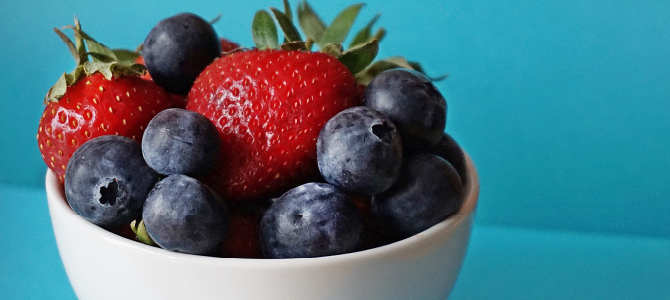What are anthocyanins and why do I need them in my diet?
December 14, 2021

Anthocyanins are a type of flavonoid—compounds that are found in plants, fruits, and vegetables and can act as antioxidants. These anthocyanin compounds are what provide red, blue, and purple colors to all your favorite fruits, vegetables, and even flowers. And it turns out they do more than just make these foods look pretty—they also have a lot of health benefits, too!
Let’s take a quick look at anthocyanins, learn about what foods they are in, and talk about some of the research that has been conducted that looks at the potential benefits we can enjoy when we include more anthocyanins in our diet.
Where are anthocyanins found?
As mentioned before, anthocyanins are what give certain fruits and vegetables their deep red, purple, and blue colors. The color anthocyanins provide depends largely on the structure of the anthocyanins present, with the pH and temperature also influencing the color. Some of the main subclasses of anthocyanins are cyanidin, delphinidin, malvidin, peonidin, petunidin, and pelargonidin. Foods that contain anthocyanins include strawberries, blueberries, bilberries, purple cabbage, purple carrots, black rice, and many others. Even though many of us know how important it is to eat a rainbow of different colored foods, these colorful foods are missing in many diets in countries around the world. Research also indicates that increasing our intake of anthocyanins may provide certain health benefits.

Benefits of Anthocyanins
If you’ve never heard of anthocyanins before, you’re not alone! Anthocyanins have only recently started gaining popularity as researchers try to figure out what health benefits these interesting molecules provide. So far, the research behind anthocyanins indicates that they may help support various aspects of our health. Some potential benefits include providing antioxidant, cardiovascular, and gut health support, although these are only a few examples of the many incredible properties of these compounds.
Antioxidant Health
Antioxidants are compounds that help to neutralize the potentially damaging effects of unstable molecules inside our bodies called free radicals. If we are exposed to, or if our body produces too many of these free radicals, it is hard for our body’s internal antioxidant network to keep up. So, it’s important that we get some of these beneficial compounds from our diets. Typically, we think of the most common antioxidants, like vitamins C and E, but there are many other compounds that act as antioxidants including anthocyanins.
Numerous studies have revealed that anthocyanins have antioxidant capabilities and can inhibit the damaging effects of reactive oxygen species.
Cardiovascular Health
Cardiovascular health refers to the health of our heart and blood vessels, i.e., our circulatory system. This important system is responsible for delivering nutrients and oxygen all throughout the body. We should always be looking for ways to help improve and support our cardiovascular health. One simple way is to include more anthocyanins in our diets. In studies that have looked at lifestyle habits of large populations of people, those who included more anthocyanins in their diet were shown to have a positive correlation with better cardiovascular health.

Gut Health
Our unhealthy modern lifestyles have us spending more time sitting and eating an ever-increasing amount of processed and unhealthy foods, and our body’s gut bacteria, or microbiome, is suffering. Anthocyanins can help support our body’s microbiome. These dark-colored pigments can promote a beneficial change in our gut by helping to improve the permeability of the intestinal tract. When we say permeability, we are talking about how easily something can pass through an object or barrier. For example, we wouldn’t want the roofs of our houses to be very permeable, or every time it rained, water would drip or pour into our homes. With our gut, improved permeability means we help keep toxins from passing through the intestinal barrier while still allowing important things like nutrients and water to enter the body and go wherever they are needed.
How do I get more anthocyanins in my diet?
Nutrition surveys have shown that we do not get enough of these colorful compounds in our diet. So, what can we do to change that? One simple idea is to look for more color when we go to the supermarket to get our groceries. Instead of just buying the same old frozen vegetables we might normally get, we could spend some time walking around the fresh produce section to look for these wonderfully colored foods. Berries, like blueberries and strawberries (often available both fresh and frozen), eggplants, purple cabbage, black rice, and other foods are very common at most grocers and are an easy place to start.
Anthocyanins are amazing compounds, and we are excited for what future research will show us about other potential benefits of getting more of them in our diets. Be on the lookout for future articles about anthocyanins to continue learning more!

Written by:
Josh Wadsworth
Technical Communications & Education Manager
Pharmanex
-
Collagen is a key structural protein found throughout the body and plays an essential role in supporting the structure and function of the body. You have probably seen or heard about many different collagen supplements on the market. You may wonder: does taking a collagen supplement provide any real benefit, or are the proclaimed benefits of collagen all hype and no substance? The truth is collage...
-
Adaptogens are natural herbs or roots that help your body adapt to or resist stress. They are usually consumed as a supplement, food item, or tea. But what exactly do adaptogens do?

